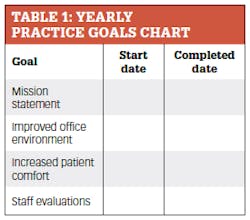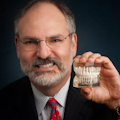Put it in writing: An effective strategy for achieving practice goals
It's my goal to present you with the challenge of building the practice you want, or modifying the practice you have. Creating a mission statement and getting staff buy-in is a crucial building block on the way to meeting this challenge. With that, I put forth some skills and methods that I hope will make your journey easier.
More by this author:
- Do you have DDS or DMD?
- How to help your staff improve
- The first building block for success: Your mission statement
Every January many of us make resolutions for the new year, and as the proverb goes, “The road to hell is paved with good intentions.” Most people intend to do good but fail because they are lazy or weak. You made it through dental school, so you can’t be lazy or weak.
What have you accomplished this year and what did you not do but wish you had? It is okay if you did not reach the mark. Focus onAvoid broad statements such as “make more money,” “take more time off,” or “learn to do implants.” Think about things in small bites, such as reducing waste, or leaving on time, or improving a skill. What are you referring out that you should be doing in-house but don't feel comfortable with?
Here's an easy one that’s so simple to learn: direct composite anterior restorations that are cosmetic. When I started doing this years ago, I picked a patient who could not afford treatment and explained what I wanted to do. We did the case together—I learned a lot and she was thrilled. You could do this with any procedure. After many classes and lots of model work, I did my first 10 implant cases for free, explaining the situation to each patient.
Set small, specific goals for 2023 and give yourself a time frame for completion. Remember: If you don’t write it down, you won’t do it. Saying, “I want to do bilateral sinus lifts with implant placement at the same time but have never done an implant” is not the way to go. It might sound outlandish, but dentists go to full-mouth reconstruction courses having never done more than singles and three-unit bridges.
Another common goal is reducing overhead. If you think about it, most people would say that payroll is the greatest expense, between 23%–27% of overhead. If your overhead is 65%, that means for every $100 you get to keep $35. Is that accurate? Are you considering real costs related to depreciation, money set aside for new equipment, retirement, insurance, and unforeseen emergencies?
When you want to reduce overhead, you must do it 1% or less at a time in different areas of your practice. Does that mean buying smart or does it mean reducing waste? I could go in any practice in the country and find tons of things that are not being used, out of date, or just plain wasted. Many years ago, my wife and I did some in-office practice management. The funniest thing we ever saw was a closet with 60 boxes of BIC pens. No logos, just pens. I am sure they are still using those pens 35 years later.
When we want to balance the art, science, and business of dentistry, we must make a plan and put it in writing. We accomplished so much in 2022 and this year we have more to go. Here’s to success and balance in 2023!
Editor's note: This article appeared in the January 2023 print edition of Dental Economics magazine. Dentists in North America are eligible for a complimentary print subscription. Sign up here.
About the Author
Jeffrey C. Hoos, DMD
Jeffrey C. Hoos, DMD, a 1978 graduate of the Tufts University School of Dental Medicine, started his private practice as a one-operatory walk-up and grew it to a four-doctor practice with 25 staff members. He lectures on innovative techniques that balance the art, science, and business of dentistry. He is one of the first general dentists to be Brånemark certified for implant placement, and his office has become a teaching center for restorative and implant dentistry. Contact him at [email protected].


